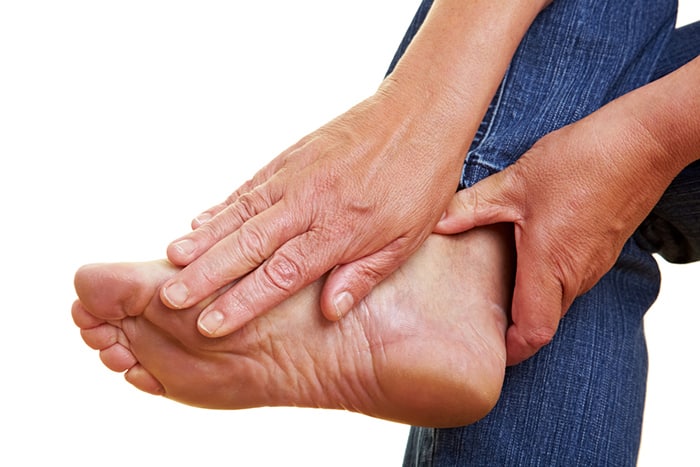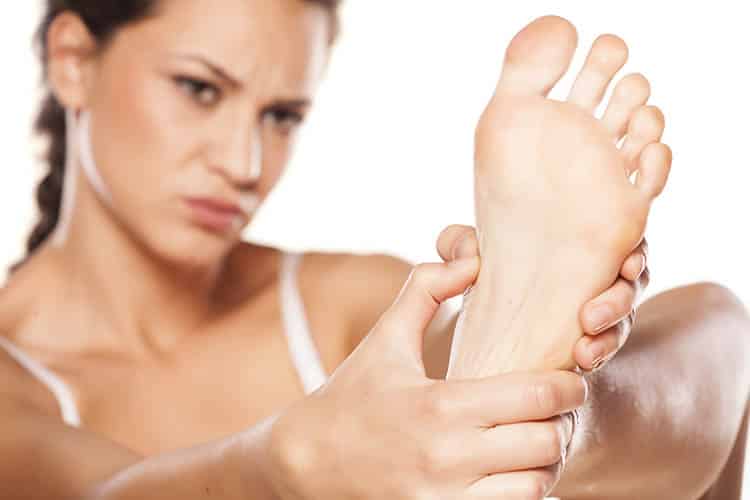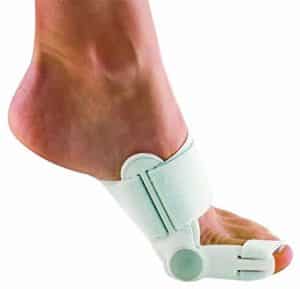Inflammation of the toe joints
Last updated 27/12/2023 by The pain clinics - Interdisciplinary Health
Inflammation of the toe joints
Inflammation of the toe joints can occur due to a variety of causes. Typical symptoms of inflammation of the toe joints are local swelling, reddish irritated skin and pain when pressing. An inflammation (mild inflammatory response) is a normal natural response when soft tissue, muscles or tendons become irritated or damaged - as can often be seen by e.g. hallux valgus. When tissue is damaged or irritated, the body will try and increase blood circulation to the area - this leads to pain, local swelling, heat development, reddish skin and pressure soreness. The swelling in the area can also lead to a nerve compression, which we can see in, among other things tarsal tunnel syndrome where the tibial nerve is pinched. These symptoms will vary in intensity depending on the injury or irritation of the tissue.
It is important to distinguish between inflammation (inflammation) and infection (bacterial or viral infection). Inflammation of the toe joints can occasionally be linked to the consept of rheumatism. We would otherwise like to emphasize that many 'inflammations' are not necessarily inflammation, but rather muscle or tendon dysfunction / injury. Please take contact us on our Facebook page if you have any questions or comments.
Causes of inflammation of the ankles
As mentioned, inflammation or inflammation is a natural response from the immune system to repair an injury or irritation. This may occur due to overuse (without sufficient musculature to perform the task) or due to minor injuries. Here are some diagnoses that can cause inflammation or inflammatory reactions in the joints:
Arthritis (Arthritis)
Osteoarthritis (the pain depends on which joints are affected)
Hallux valgus (can lead to red and swollen big toe)
Morton's neuroma (causes electrical pain in between the toes, front of the foot)
Plantar fascite (causes pain in the foot leaf, along the plantar fascia from the protrusion of the heel)
Gout (most commonly found in the first metatarsus joint, on the big toe)
rheumatism (the pain depends on which joints are affected)
Tarsal tunnel syndrome aka Tarsal tunnel syndrome (usually causes quite intense pain on the inside of the foot, heel)
Who is affected by inflammation of the toe joints?
Absolutely everyone can be affected by an inflammation in the toe joints - as long as the activity or load exceeds what the soft tissue, tendons, joints or muscles can withstand. Those who increase their training too fast, especially in jogging, sports, weightlifting and especially those with a high repetitive load on the ankle and foot are most exposed - especially if the majority of the load is on a hard surface. Malpositions in the feet (overpronation and flatfoot) can also be a contributing cause of developing inflammatory reaction in the toe joints.
Inflammation of the toe joints can be very bothersome. If an inflammation occurs then you have to keep in mind that in most cases it is self-inflicted (a lot of walking on hard surfaces with lack of training of supporting muscles for example?), And that you are smart in listening to what the body is trying to tell you . If you do not listen to the pain signals, the condition can be chronically damaged.
Symptoms of inflammation of the ankles
Pain and symptoms will depend on the extent to which the ankles have an inflammatory reaction. We remind you again that an inflammation and an infection are two completely different things - if you get a severe inflammatory reaction with heat development, fever and pus in the area, then you have an infection, but we will go into more detail in another article. Typical symptoms of inflammation include:
- Local swelling
Reddish, irritated skin
- Painful when pressing / touching
Recommended products for pain relief

Biofreeze (Cold / cryotherapy)

Diagnosis of inflammation of the toe joints
A clinical examination will be based on history and an examination. This will show reduced movement in the affected area and local tenderness. You will not normally need a further imaging examination - but in certain cases it may be relevant with an imaging examination to check whether an injury is the cause of the swelling or blood tests. A rheumatic examination may also be relevant if there is any suspicion rheumatic disorders.
Image diagnostic examination of inflammation of the tendon joints (X-ray, MRI, CT or ultrasound)
An X-ray can rule out any fracture damage. One MRI examination can show if there is any damage to tendons or structures in the area. Ultrasound can examine whether there is tendon damage - it can also see if there is fluid accumulation in the area.
Treatment of inflammation of the toe joints
The main purpose of treating inflammation in the toe joints is to remove any cause of the inflammation and then let the toe joints heal themselves. As mentioned earlier, an inflammation is a completely natural repair process where the body increases blood circulation to the area to ensure faster healing - unfortunately it is so that sometimes the body can do a slightly good job and it may then be necessary with icing, anti-inflammatory laser and possible use of anti-inflammatory drugs (we remind you that overuse of NSAIDS can lead to a reduced repair in the area). Cold treatment can provide pain relief for sore joints and muscles, also in the toe joints. Blue. Biofreeze (opens in a new window) is a popular natural product. One should always try conservative treatment for a long time before resorting to invasive surgery (surgery and surgery), but in some cases this is the only way out. Direct conservative measures can be:
- Foot care (foot care and physical therapy can provide pain relief)
- Rest (take a break from what caused the injury)
- Insole (this can lead to a more correct load on the foot and foot)
- Toe support / Hallux valgus support
RELATED PRODUCT / SELF-HELP: - Hallux Valgus Support
Plagued with hallux valgus (crooked big toe) and / or bone growth (bunion) on the big toe? Then this can be part of the solution to your problem!
Exercises and stretching
Exercises against inflammation in the toe joints
One should try to cut out too much weight-bearing exercise if one is afflicted with inflammation in the toe joints. Replace jogging with swimming, elliptical machine or exercise bike. Also, make sure that you stretch your foot and train your feet lightly as shown this article.
Related article: - 4 good exercises for sore feet!
NEXT PAGE: - Sore toes? You should know this!
Also read:
- Pressure wave treatment of plantar fascite
- Exercises and stretching of plantar fascia heel pain
Popular article: - Is it tendonitis or tendon INJURY?
Most shared article: - New Alzheimer's treatment restores full memory function!
Training:
- Cross-trainer / ellipse machine: Excellent fitness training. Good for promoting movement in the body and exercising overall.
- Rowing Machines is one of the best forms of training you can use to get good overall strength.
- Spinning ergometer bike: Good to have at home, so you can increase the amount of exercise throughout the year and get better fitness.
Sources:
-
Questions about inflammation of the toe joints:
What does it mean to have inflammation / inflammation in the toe joints?
Inflammation of the toe joints is synonymous with the body's own reaction to injuries and the like. The goal is to remove damaged cells, pathogens or the like. This can lead to temporary swelling and slightly reddish development in the area. It is important to distinguish between inflammation and infection - because there are two very different things.
 Follow Vondt.net on YOUTUBE
Follow Vondt.net on YOUTUBE
(Follow and comment if you want us to make a video with specific exercises or elaborations for exactly YOUR issues)
 Follow Vondt.net on FACEBOOK
Follow Vondt.net on FACEBOOK
(We try to respond to all messages and questions within 24-48 hours. We can also help you interpret MRI responses and the like.)














Leave a reply
Want to join the discussion?Feel free to Contribute!